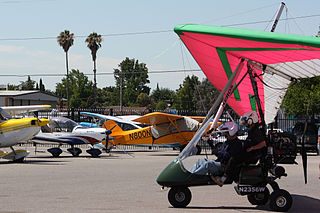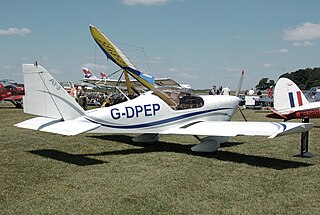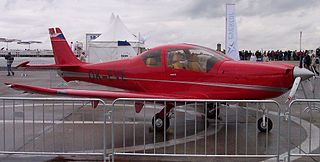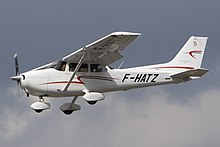The Federal Aviation Regulations (FARs) are rules prescribed by the Federal Aviation Administration (FAA) governing all aviation activities in the United States. The FARs comprise Title 14 of the Code of Federal Regulations. A wide variety of activities are regulated, such as aircraft design and maintenance, typical airline flights, pilot training activities, hot-air ballooning, lighter-than-air aircraft, human-made structure heights, obstruction lighting and marking, model rocket launches, commercial space operations, model aircraft operations, unmanned aircraft systems (UAS) and kite flying. The rules are designed to promote safe aviation, protecting pilots, flight attendants, passengers and the general public from unnecessary risk.

In flight dynamics a spin is a special category of stall resulting in autorotation about the aircraft's longitudinal axis and a shallow, rotating, downward path approximately centred on a vertical axis. Spins can be entered intentionally or unintentionally, from any flight attitude if the aircraft has sufficient yaw while at the stall point. In a normal spin, the wing on the inside of the turn stalls while the outside wing remains flying. It is possible for both wings to stall, but the angle of attack of each wing, and consequently its lift and drag, are different.

The European Union Aviation Safety Agency (EASA) is an agency of the European Commission with responsibility for civil aviation safety in the European Union. It carries out certification, regulation and standardisation and also performs investigation and monitoring. It collects and analyses safety data, drafts and advises on safety legislation and co-ordinates with similar organisations in other parts of the world.

The Extra Flugzeugbau EA300 is a two-seat aerobatic monoplane capable of Unlimited category competition. It was designed in 1987 by Walter Extra, a German aerobatic pilot, and built by Extra Flugzeugbau.

The Extra 200 is a two-seat, tandem arrangement, low-wing aerobatic monoplane with conventional (taildragger) landing gear fully capable of Unlimited category competition, built by Extra Flugzeugbau.

A light-sport aircraft (LSA), or light sport aircraft, is a category of small, lightweight aircraft that are simple to fly. LSAs tend to be heavier and more sophisticated than ultralight aircraft, but LSA restrictions on weight and performance separates the category from established GA aircraft. There is no standard worldwide description of an LSA.

The Canadian Aviation Regulations define two types of ultralight aircraft: basic ultra-light aeroplane (BULA), and advanced ultra-light aeroplane (AULA).

EASA CS-VLA is the European Aviation Safety Agency Certification Specification for Very Light Aircraft.
In aeronautics, the load factor is the ratio of the lift of an aircraft to its weight and represents a global measure of the stress ("load") to which the structure of the aircraft is subjected:

Cross-country flying is a type of distance flying which is performed in a powered aircraft on legs over a given distance and in operations between two points using navigational techniques; and an unpowered aircraft by using upcurrents to gain altitude for extended flying time. Cross country is distinct from purely aerial work in a small defined area requiring little navigation.

A utility aircraft is a general-purpose light airplane or helicopter, usually used for transporting people, freight, or other supplies, but also used for other duties when more specialized aircraft are not required or available.

In aviation, a class rating is an allowance to fly a certain group of aircraft that require training common to all aircraft within the group. A type rating is specified if a particular aircraft requires additional specialized training beyond the scope of initial license and aircraft class training. Which aircraft require a type rating is decided by the local aviation authority. Almost all single-engine piston (SEP) or multi-engine piston (MEP) single pilot aircraft can be flown without a type rating, but are covered by a class rating instead.

The Pipistrel Virus is a two-seat, single engine light aircraft manufactured by Pipistrel in Slovenia and Italy and sold as an ultralight, homebuilt kit, or light-sport aircraft.

The Allstar SZD-54 Perkoz is a two-seater, glider for training, aerobatics, cross country flight and cloud flying from the Polish manufacturer Allstar PZL Glider. The sailplane has exchangeable wing tips for either 17.5 or 20 metres and is manufactured primarily from glass fibre reinforced plastic (GFRP). Without wing extension, it is certified for unlimited aerobatic manoeuvres. For glider training, the short wingspan is supplemented with winglets. As a cross-country glider with a 20 metres wing and winglets, the Perkoz has a glider index of 102. The SZD-54-2 Perkoz is the successor of the widely used SZD-50-3 Puchacz trainer, which is part of the SZD family of aircraft.

The Evektor VUT100 Cobra is a Czech light aircraft under development by Evektor-Aerotechnik, of Kunovice. The aircraft is intended to be supplied as a complete ready-to-fly-aircraft.
The minimum control speed (VMC) of a multi-engine aircraft is a V-speed that specifies the calibrated airspeed below which directional or lateral control of the aircraft can no longer be maintained, after the failure of one or more engines. The VMC only applies if at least one engine is still operative, and will depend on the stage of flight. Indeed, multiple VMCs have to be calculated for landing, air travel, and ground travel, and there are more still for aircraft with four or more engines. These are all included in the aircraft flight manual of all multi-engine aircraft. When design engineers are sizing an airplane's vertical tail and flight control surfaces, they have to take into account the effect this will have on the airplane's minimum control speeds.
NATO STANAG 4671 is the NATO Standardized Agreement 4671 which is the UAV SYSTEM Airworthiness REQUIREMENTS (USAR). It is intended to allow military Unmanned aerial vehicles (UAVs) to operate in other NATO members airspace.

The Pipistrel Velis Electro is a Slovenian light aircraft, designed and produced by Pipistrel of Ajdovščina. The aircraft was EASA CS-LSA fully electric type certified in June 2020 and it is intended primarily for the training aircraft role, particularly multiple successive take-off and landings at the airfield. The design is the first type certified electric aircraft and is supplied complete and ready-to-fly.
An aircraft category is defined by the International Civil Aviation Organization as a "classification of aircraft according to specified basic characteristics", for the purpose of personnel licensing. Examples of aircraft categories include aeroplanes, helicopters, gliders, or free balloons.

EASA CS-25 is the European Union Aviation Safety Agency Certification Specification for Large Aeroplanes.















